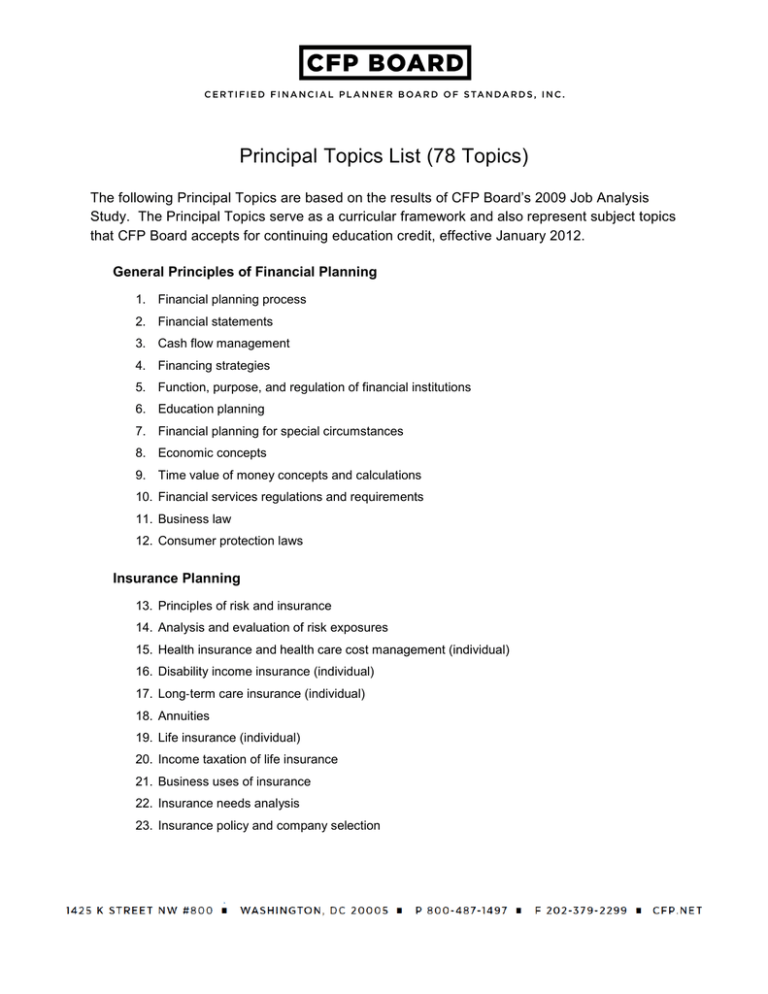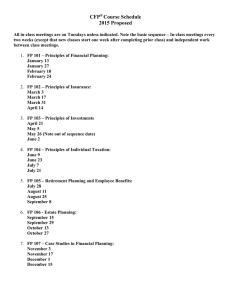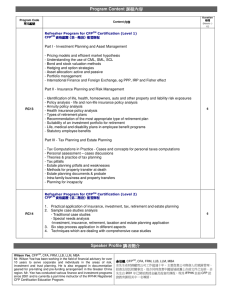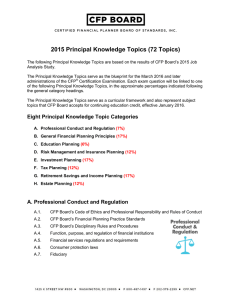
Principal Topics List (78 Topics)
The following Principal Topics are based on the results of CFP Board’s 2009 Job Analysis
Study. The Principal Topics serve as a curricular framework and also represent subject topics
that CFP Board accepts for continuing education credit, effective January 2012.
General Principles of Financial Planning
1. Financial planning process
2. Financial statements
3. Cash flow management
4. Financing strategies
5. Function, purpose, and regulation of financial institutions
6. Education planning
7. Financial planning for special circumstances
8. Economic concepts
9. Time value of money concepts and calculations
10. Financial services regulations and requirements
11. Business law
12. Consumer protection laws
Insurance Planning
13. Principles of risk and insurance
14. Analysis and evaluation of risk exposures
15. Health insurance and health care cost management (individual)
16. Disability income insurance (individual)
17. Long‐term care insurance (individual)
18. Annuities
19. Life insurance (individual)
20. Income taxation of life insurance
21. Business uses of insurance
22. Insurance needs analysis
23. Insurance policy and company selection
Investment Planning
24. Characteristics, uses and taxation of investment vehicles
25. Types of investment risk
26. Quantitative investment concepts
27. Measures of investment returns
28. Asset allocation and portfolio diversification
29. Bond and stock valuation concepts
30. Portfolio development and analysis
31. Investment strategies
Income Tax Planning
32. Income tax law fundamentals
33. Tax compliance
34. Income tax fundamentals and calculations
35. Characteristics and income taxation of business entities
36. Income taxation of trusts and estates
37. Basis
38. Tax consequences of the disposition of property
39. Alternative minimum tax (AMT)
40. Tax reduction/management techniques
41. Passive activity and at-risk rules
42. Tax implications of special circumstances
43. Charitable contributions and deductions
Retirement Planning
44. Retirement needs analysis
45. Social Security (Old Age, Survivor, and Disability Insurance, OASDI)
46. Types of retirement plans
47. Qualified plan rules and options
48. Other tax-advantaged retirement plans
49. Regulatory considerations
50. Key factors affecting plan selection for businesses
51. Investment considerations for retirement plans
52. Distribution rules, alternatives, and taxation
Page 2 of 3
Estate Planning
53. Characteristics and consequences of property titling
54. Methods of property transfer at death
55. Estate planning documents
56. Gifting strategies
57. Gift tax compliance and tax calculation
58. Incapacity planning
59. Estate tax compliance and tax calculation
60. Sources for estate liquidity
61. Powers of appointment
62. Types, features, and taxation of trusts
63. Qualified interest trusts
64. Charitable transfers
65. Use of life insurance in estate planning
66. Marital deduction
67. Intra-family and other business transfer techniques
68. Deferral and minimization of estate taxes
69. Generation-skipping transfer tax (GSTT)
70. Fiduciaries
71. Income in respect of a decedent (IRD)
72. Postmortem estate planning techniques
73. Estate planning for non-traditional relationships
Interpersonal Communication
74. Client and planner attitudes, values, biases and behavioral characteristics and the impact
on financial planning
75. Principles of communication and counseling
Professional Conduct and Fiduciary Responsibility
76. CFP Board’s Code of Ethics and Professional Responsibility and Rules of Conduct
77. CFP Board’s Disciplinary Rules and Procedures
78. CFP Board’s Financial Planning Practice Standards
Copyright © 2010-2012, Certified Financial Planner Board of Standards, Inc. All Rights Reserved
Page 3 of 3




